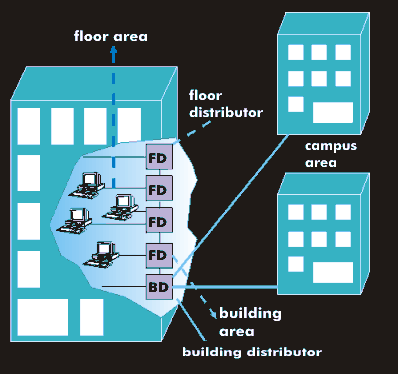cabling principles
When cabling buildings, some guidelines should be observed that guarantee high flexibility and long-term investment protection.
Based on structured cabling in accordance with the cabling standard, only symmetrical cables, i.e. TP cables, and fiber optic cables are used as transmission media as a matter of principle. In building cabling, the aim should be to keep cable runs as short as possible to facilitate installation. To this end, the distribution rooms with their floor distributors should be arranged one above the other on the individual floors. Each floor should have its own distribution room. Such a distribution room must provide sufficient space to accommodate all distribution and transmission equipment, such as telephone distributors, hubs, patch panels, etc. Distribution cabinets should be provided for the orderly placement of this equipment.
One such distribution point should be provided for each approximately 1000 sq. ft. of floor area and, if possible, should be designed for fewer than 500 connections. From the floor distributor, four-core, or preferably eight-core, cables are laid in a star configuration to the telecommunications connection boxes at the workplace. It is absolutely necessary to clearly identify the connections in the distribution area in order to avoid tedious search procedures later on.
Each workstation should have two to three connection sockets.
The assignment of new services or any necessary reconfigurations due to relocations are carried out by patching in at the floor or building distributor.

